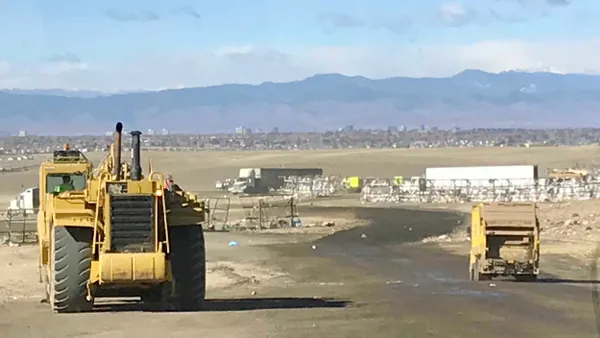UPDATE April 9, 2018: The New York Department of Environmental Conservation (DEC) has granted all necessary permits for the proposed Colonie landfill expansion, as reported by Spotlight News.
The decision is detailed in two April 5 letters posted on the landfill's website. This includes approval for new solid waste, wetlands and water quality certification permits through April 2028. The agency also granted modification approval for air quality permits.
This news comes as the neighboring municipalities of Waterford and Halfmoon recently asked the DEC to delay its decision by 30 days and allow for additional public comment about the final environmental impact statement, as reported by the Times Union.
Dive Brief:
- The New York Department of Environmental Conservation (DEC) is expected to decide on a proposed expansion of the Town of Colonie Landfill within the next 10 days, as reported by the Times Union. Per the final environmental impact statement released this week, that expansion has been scaled down from 105 acres to 93 acres.
- Other changes include a new setback from the Mohawk River of 500 feet (versus 100 feet) and a vertical expansion of 30 feet (versus 87 feet). Two 500,000-gallon leachate storage tanks would be constructed to move away from the current open storage system. A third-party monitor would also have to be present, at the expense of site operator Waste Connections, as reported by Spotlight News.
- The nearby towns of Waterford and Halfmoon remain opposed to the expansion, and joined the nonprofit Riverkeeper in raising concerns about related contamination in the Mohawk River and surrounding areas. According to recent groundwater tests analyzed by Cornell University, elevated levels of PFOA were identified. The DEC told WNYT that Cornell's lab is not certified by the state.
Dive Insight:
The Colonie site is expected to reach capacity imminently and the expansion was envisioned to provide 20 more years, though the scaled-back version may reduce that estimate by four or five years. Waste Connections took over operations in 2011 through a 25-year lease agreement and has helped spearhead this expansion process, which began with a permit application in 2016.
According to a website run by the company, the Colonie landfill has been active since the 1960s and has accepted an estimated 6 million cubic yards of material so far. Some of that waste is stored in an unlined area, which Waste Connections says would be covered in this expansion with a double composite liner for any new material. Officials from Waterford and Halfmoon have raised concerns about pressure from new waste causing leachate to seep into the ground and pollute the nearby Mohawk River.
The site's proximity to the river, combined with ongoing concerns about PFOA contamination, has further complicated the process. Past studies commissioned by multiple towns last fall have found low levels of PFOA — all under the Environmental Protection Agency's 2016 70 parts per trillion advisory — though the Cornell analysis found 519 ppt.
PFOA — part of the broader polyfluoroalkyl substances (PFAS) chemical group — was traditionally used in textiles, cookware and flame retardants. While no longer common in new U.S. products, the chemicals are present around many older landfills or manufacturing sites and are a growing concern for upstate New York communities. Debate continues about the appropriate contamination threshold, with some states differing from the EPA, and litigation against major companies has ramped up in recent years. No litigation has been introduced in relation to the Colonie site.
As with any expansion decision, the question of what happens if it isn't approved must also be raised. Another nearby landfill in Albany is similarly running out of capacity. If Colonie doesn't expand, waste could be sent west to larger upstate landfills that are dealing with their own community relations challenges.










